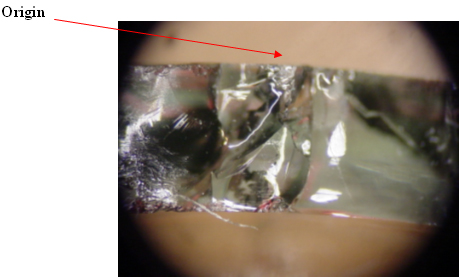Note: Glass fractography is the most effective method for determining why a glass object, such as a bottle, failed. This technique consists of examining the fracture surfaces of the failure for artifacts such as Wallner lines and using them to trace the crack back to its origin. Once the origin has been identified, it can be examined in detail with a microscope to determine the cause of the failure.
Jar Failure
Overview: Figure #1 is an overview of the failed jar. During opening, the jar separated into two pieces and injured the person attempting to open it.
Failure Origin: Figure #’s 2 & 3 give two views of the failure origin. This fracture originated from a blow to the side of the jar. The force of this strike created a ‘star’ pattern of damage with numerous cracks leaving the center point. One of these cracks was in the proper orientation to complete the failure when an attempt was made to twist off the top. A portion of the star pattern is shown in Figure #2. Figure #3 shows the origin as it appears on the fracture surface.
Lid damage: Figure #4 is a macro-photograph of the origin that also shows the condition of the lid in the same locality. This photograph demonstrates clearly that the lid was hit in the same region as the fracture origin.
Conclusion
The jar failed as a result of a blow to its side. Damage to the lid indicates that it was being hit in order to loosen it. Jars that contain jams, jellies and other contents high in sugar often have the lids stuck after re-sealing. The liquid sugar solidifies and tends to ‘glue’ the lid in place. Hitting the lid is neither an effective way to loosen it, nor is this a safe technique. As demonstrated above one can hit the glass and initiate a crack that can cause the jar to fail when the lid is being twisted off. Often the person removing the lid can be injured by the sharp glass created by the failure. A better method is to immerse the jar in warm water to soften the ‘glue’ before trying to twist the lid off.

Figure #1: Overview of a failed jam jar. The top section came off during an attempt to remove the lid by twisting.

Figure #2: Photomicrograph of the side view of the fracture origin. This failure resulted from a blow to the side of the jar. This is demonstrated by the cracks radiating from the point where the blow struck the side of the jar. (Mag. 8X)

Figure #3: Origin of the failure as it appears on the fracture surface. This crack originated from a blow to the outside of the jar. The fracture originated on the outer surface of the jar and worked its way inward and laterally. (Mag. 40X)

Figure #4: Macro-photograph of the top of the jar. It clearly shows the failure origin. In addition, it also shows damage to the lid. The lid damage indicates that it has been hit with a hard object. Often a person will bang a stuck lid to free it so it can be removed. In this case one of the strikes missed the lid and hit the outer surface of the jar; in addition, it was severe enough to crack the glass.




